Hydrangea landscaping is a fantastic way to bring life and color to your garden. With their stunning blooms ranging from soft pastels to vibrant hues, hydrangeas can create a beautiful focal point for any outdoor space. These versatile plants thrive in various conditions and offer something special through all seasons, making them a popular choice for both novice and seasoned gardeners. Whether used as borders, hedges, or standalone specimens, hydrangeas can truly make your landscape shine.
Pairing Hydrangeas with Other Plants
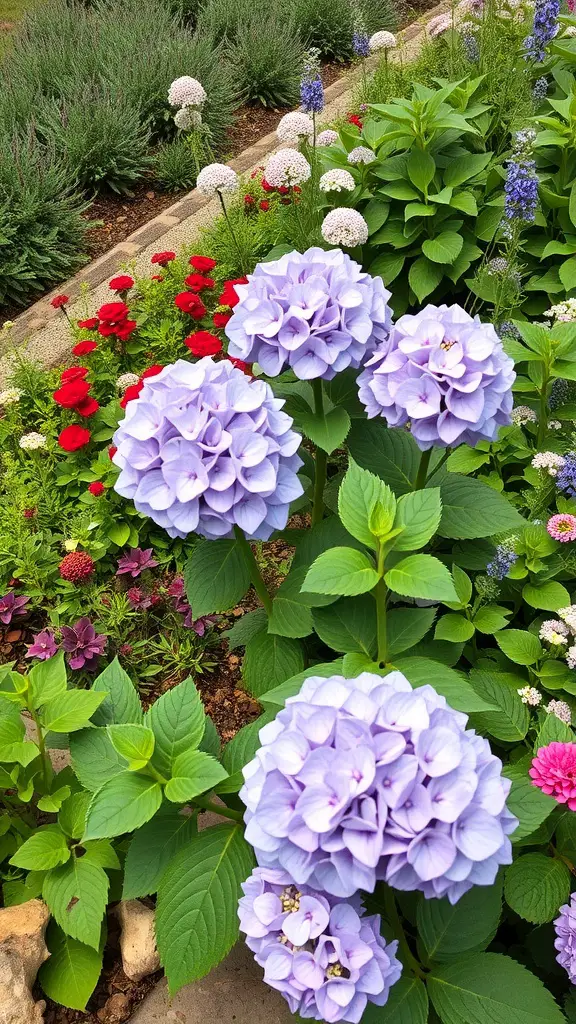
Hydrangeas are stunning flowers that bring a pop of color to any garden. In the image, you can see beautiful lavender hydrangeas surrounded by a mix of vibrant flowers and greenery. This combination creates a lively and inviting atmosphere.
When pairing hydrangeas with other plants, consider their colors and textures. The soft lavender of the hydrangeas contrasts nicely with the bold reds and deep purples nearby. This variety adds depth and interest to the landscape.
Adding plants like lavender or ornamental grasses can enhance the overall look. Their different heights and shapes create a layered effect. Plus, the scent of lavender complements the hydrangeas beautifully.
Don’t forget about seasonal blooms! Incorporating flowers that bloom at different times can keep your garden looking fresh throughout the year. This way, you’ll have something new to enjoy as the seasons change.
Using Hydrangeas for Privacy Hedges
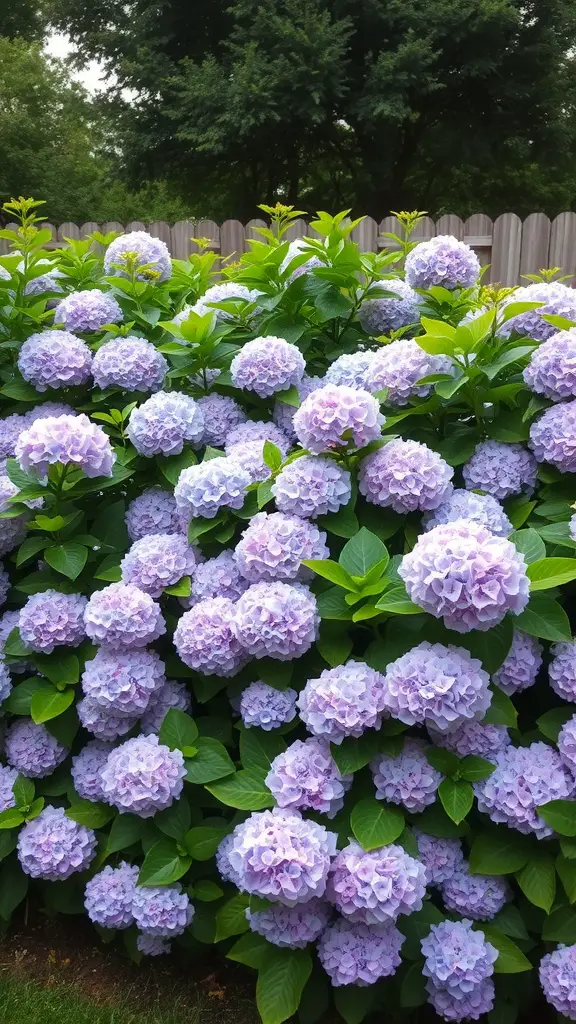
Hydrangeas are not just beautiful; they can also serve as effective privacy hedges. Their lush foliage and large blooms create a natural barrier that can shield your yard from prying eyes. In the image, you can see a vibrant hydrangea hedge bursting with clusters of soft purple flowers. This stunning display not only adds color but also provides a sense of seclusion.
When planting hydrangeas for privacy, choose a variety that grows tall and dense. The bigleaf hydrangea is a popular choice, known for its impressive blooms and ability to thrive in various conditions. Make sure to plant them close together to form a thick hedge that blocks views effectively.
Hydrangeas thrive in well-drained soil and prefer partial shade. Regular watering will keep them healthy and blooming beautifully. With the right care, your hydrangea hedge will flourish, offering both beauty and privacy for your outdoor space.
Creating Colorful Borders with Hydrangeas
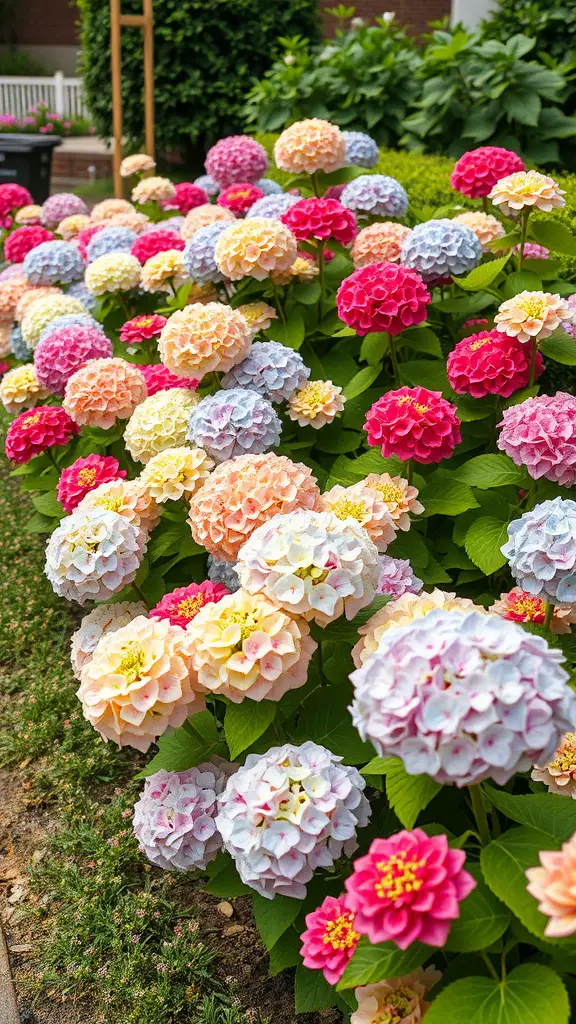
Hydrangeas are a fantastic choice for creating vibrant borders in your garden. Their large, fluffy blooms come in a variety of colors, making them perfect for adding a splash of color to any landscape. In the image, you can see a stunning array of hydrangeas in shades of pink, blue, and peach. These flowers not only catch the eye but also create a welcoming atmosphere.
When planting hydrangeas, consider their placement. They thrive in well-drained soil and prefer partial shade. This makes them ideal for borders along pathways or near patios where you can enjoy their beauty up close. The lush green leaves provide a lovely backdrop for the colorful blooms, enhancing the overall look.
Mixing different varieties can create a dynamic effect. For instance, pairing deep pink hydrangeas with softer pastel shades can create a beautiful contrast. This variety not only adds visual interest but also extends the blooming season, giving you color throughout the summer.
Don’t forget to maintain your hydrangeas! Regular watering and occasional pruning will keep them healthy and blooming beautifully. With a little care, these flowers can transform your garden into a colorful paradise.
Choosing the Right Hydrangea Varieties
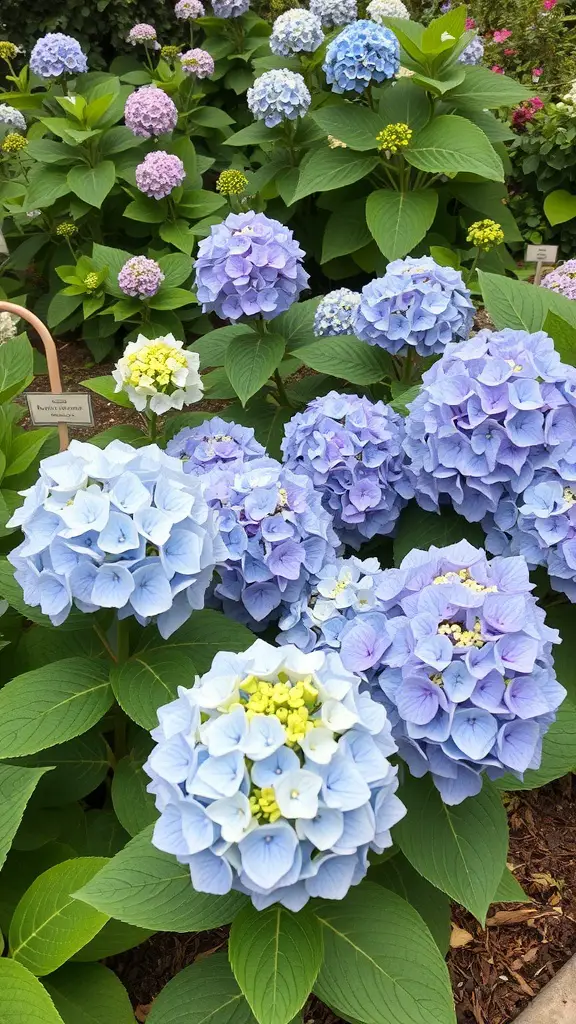
When it comes to hydrangeas, the variety you choose can make a big difference in your landscaping. The image shows a beautiful display of different hydrangea types, showcasing their stunning colors and shapes. From soft blues to vibrant pinks, these flowers can transform any garden.
One popular choice is the mophead hydrangea, known for its large, round blooms. These are often seen in shades of blue and pink, depending on soil pH. Another great option is the lacecap hydrangea, which features a more delicate flower structure. Both types can add charm and elegance to your outdoor space.
Don’t forget about the panicle hydrangeas, which are perfect for those looking for a taller plant. They can reach impressive heights and produce lovely cone-shaped flowers. Choosing the right variety depends on your garden’s size, soil type, and the look you want to achieve.
Hydrangea Maintenance for Year-Round Blooms
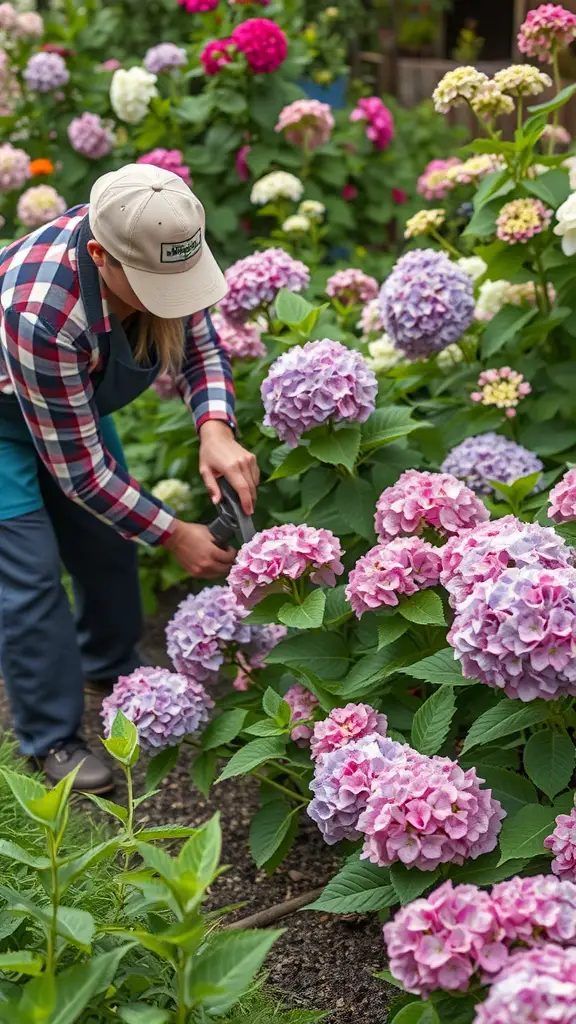
Maintaining hydrangeas is key to enjoying their beautiful blooms throughout the year. In the image, we see a gardener tending to a vibrant hydrangea garden, carefully pruning the flowers to encourage healthy growth. This hands-on approach is essential for keeping these plants thriving.
Regular pruning helps shape the plants and promotes new growth. It’s best to prune hydrangeas in late winter or early spring, just before new buds appear. This timing ensures that you won’t cut off any developing flowers.
Hydrangeas thrive in well-drained soil and need consistent moisture. Watering them deeply, especially during dry spells, keeps the plants healthy and vibrant. Adding mulch around the base can help retain moisture and suppress weeds.
Fertilizing hydrangeas in early spring can also boost their growth. A balanced fertilizer will provide the nutrients they need to produce those stunning blooms. Remember to follow the instructions on the fertilizer package for the best results.
Lastly, keep an eye out for pests and diseases. Regular checks can help catch any issues early. With a little care, your hydrangeas will reward you with beautiful blooms season after season!
Hydrangeas as Focal Points in Garden Design
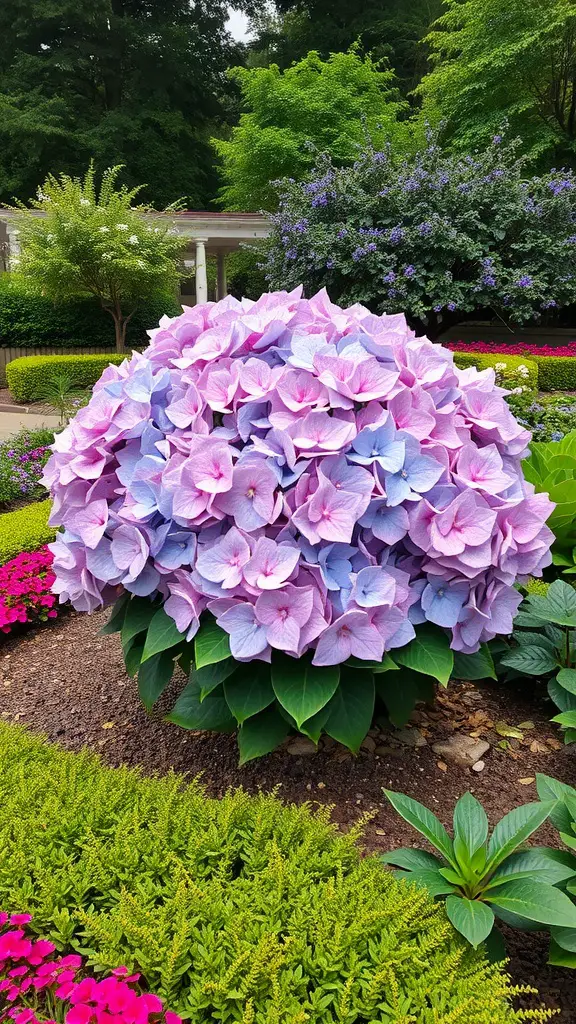
Hydrangeas are a fantastic choice for creating stunning focal points in any garden. Their large, colorful blooms can instantly draw the eye and add a pop of vibrancy to your outdoor space.
In the image, you can see a beautiful hydrangea bush bursting with shades of pink and blue. This combination not only adds visual interest but also complements the surrounding greenery. The lush leaves provide a perfect backdrop, making the flowers stand out even more.
When planning your garden, think about placing hydrangeas in spots where they can shine. They work well near pathways or at the center of flower beds. Their size and shape can create a sense of fullness, making your garden feel more inviting.
Mixing hydrangeas with other plants, like the colorful flowers seen in the image, can enhance their beauty. The contrast between the vibrant blooms and the rich green foliage creates a lively atmosphere. This approach can transform any garden into a welcoming retreat.
Incorporating Hydrangeas in Container Gardens
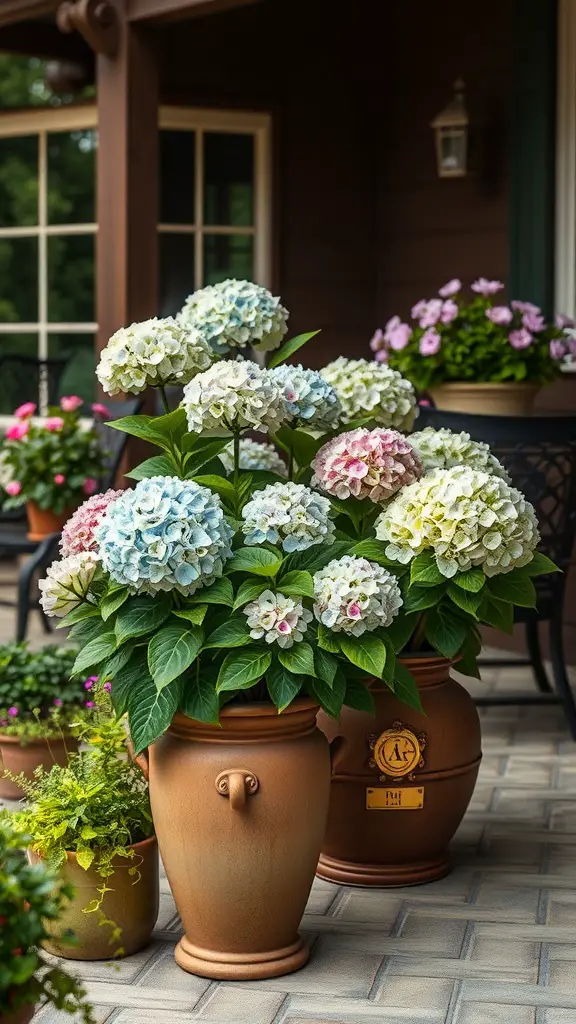
Hydrangeas are a fantastic choice for container gardens. Their lush blooms and vibrant colors can brighten up any space. In the image, you can see beautiful hydrangeas in various shades of blue, pink, and white, all thriving in stylish pots. These containers not only hold the plants but also add a decorative touch to the patio.
When planting hydrangeas in containers, it’s important to choose the right pot size. A larger pot allows for better root growth and helps retain moisture. The pots in the image are perfect examples, providing ample space for the plants to flourish. Make sure to use quality potting soil to give your hydrangeas the nutrients they need.
Placement is key too. Hydrangeas love bright, indirect sunlight. Positioning them near a window or on a patio where they can soak up the light will help them thrive. The arrangement in the image shows how well they can complement other plants, creating a lovely garden feel.
Watering is essential, especially in containers. Hydrangeas need consistent moisture, so check the soil regularly. If you notice the leaves wilting, it’s time to give them a drink. The vibrant blooms in the image suggest these plants are well cared for and thriving in their environment.
Seasonal Care Tips for Hydrangeas
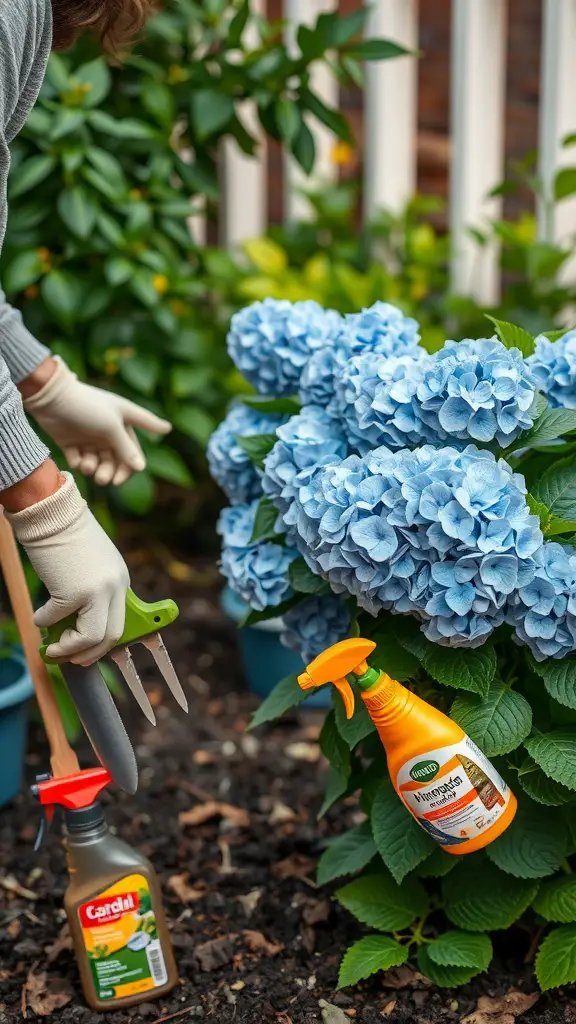
Hydrangeas are stunning plants that can bring a splash of color to any garden. In the image, we see a gardener tending to beautiful blue hydrangeas. The vibrant blooms stand out against the lush green leaves, creating a lovely scene. Caring for these plants requires some seasonal attention to keep them thriving.
In spring, it’s a great time to prune your hydrangeas. This helps promote healthy growth and encourages more blooms. Use clean, sharp tools to make precise cuts. Be sure to remove any dead or damaged branches.
During the summer, regular watering is key. Hydrangeas love moisture, so keep the soil consistently damp, especially in hot weather. You can also apply a balanced fertilizer to give them a nutrient boost.
As fall approaches, consider adding mulch around the base of the plants. This helps retain moisture and protects the roots during colder months. It’s also a good time to check for pests and treat them promptly.
In winter, protect your hydrangeas from harsh weather. If you live in a colder climate, wrapping them in burlap or using frost cloth can help shield them from freezing temperatures.
Hydrangeas for Small Spaces
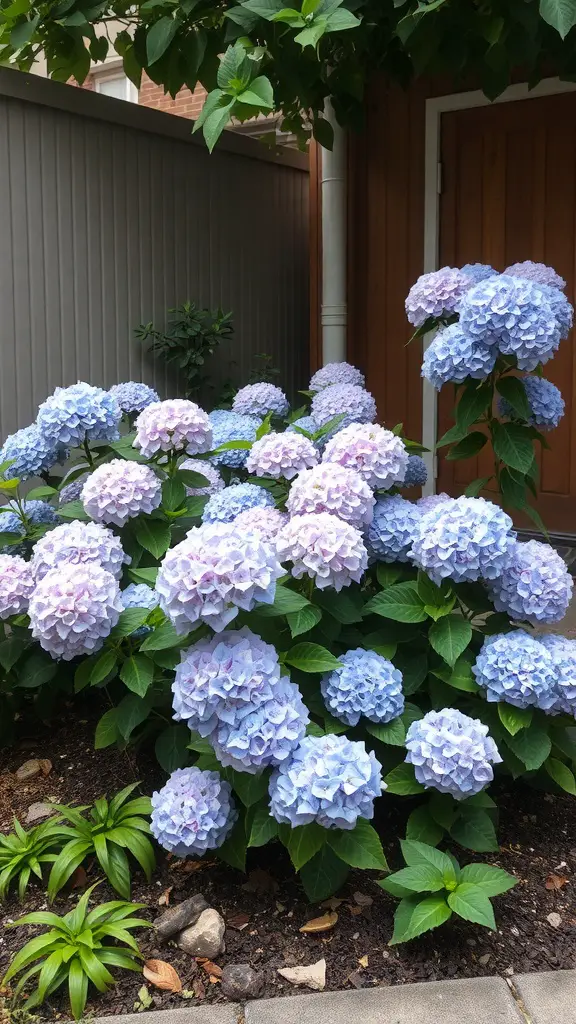
Hydrangeas are a fantastic choice for small gardens. Their beautiful blooms can add a splash of color without overwhelming the space. In the image, you can see a lovely cluster of hydrangeas with shades of blue and soft pink. These colors can brighten up any corner.
When planting hydrangeas in tight spots, consider their size. Some varieties stay compact, making them perfect for smaller areas. They can thrive in partial shade, which is great if your space doesn’t get full sun all day.
Another tip is to group them with other plants that have similar water needs. This helps keep your garden looking neat and healthy. The lush green leaves of the hydrangeas complement other plants beautifully, creating a vibrant look.
Lastly, don’t forget to think about the seasons. Hydrangeas can provide interest throughout the year, from their lush foliage in spring to their stunning blooms in summer. Even in fall, their colors can shift, adding to the charm of your small garden.
Adding Hydrangeas to Landscape Edging
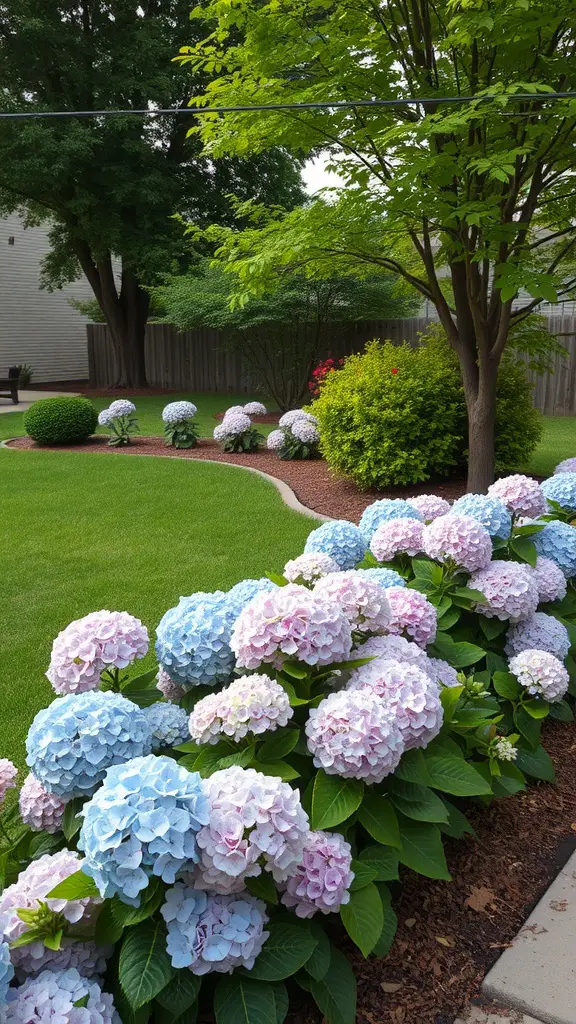
Hydrangeas are a fantastic choice for landscape edging. Their vibrant colors and lush blooms can really brighten up any garden space. In the image, you can see a beautiful arrangement of hydrangeas lining a pathway. The soft blues and pinks create a lovely contrast against the green grass and surrounding foliage.
When planting hydrangeas for edging, consider their size and growth habits. They can fill in nicely, providing a soft border that guides the eye along the path. The way they are grouped in the image shows how effective they can be in creating a cohesive look.
These flowers thrive in various conditions, making them versatile for different garden styles. Whether you prefer a more formal layout or a relaxed cottage garden feel, hydrangeas can adapt beautifully. Their blooms can last for months, adding long-lasting color to your landscape.
To maintain their beauty, regular watering and occasional pruning will help keep them healthy. With the right care, your hydrangea edging can become a stunning focal point in your yard.
Hydrangeas and Wildlife: Attracting Pollinators
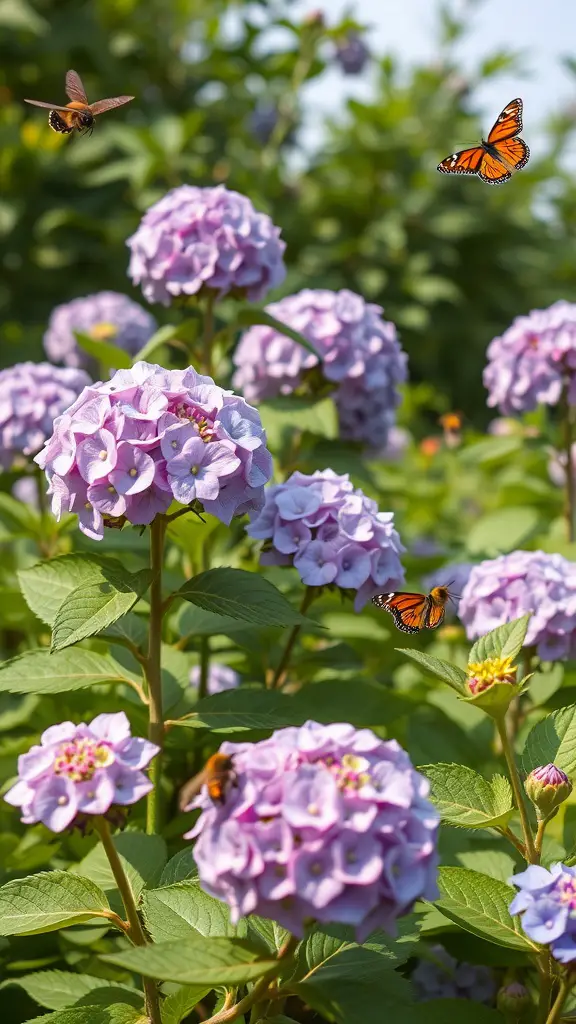
Hydrangeas are not just beautiful; they also play a vital role in attracting wildlife, especially pollinators like butterflies and bees. The image shows vibrant purple hydrangea blooms surrounded by fluttering butterflies. These colorful flowers serve as a feast for these pollinators, providing nectar that is essential for their survival.
When you plant hydrangeas in your garden, you create a welcoming environment for these creatures. The large, showy flowers are easy for butterflies to spot from a distance. As they visit the blooms, they help with the pollination process, which is crucial for many plants.
Creating a pollinator-friendly garden with hydrangeas can be a rewarding experience. Not only do you get to enjoy the stunning blooms, but you also contribute to the health of your local ecosystem. Watching butterflies dance around your hydrangeas can bring joy and a sense of connection to nature.
Creating a Hydrangea-Themed Garden
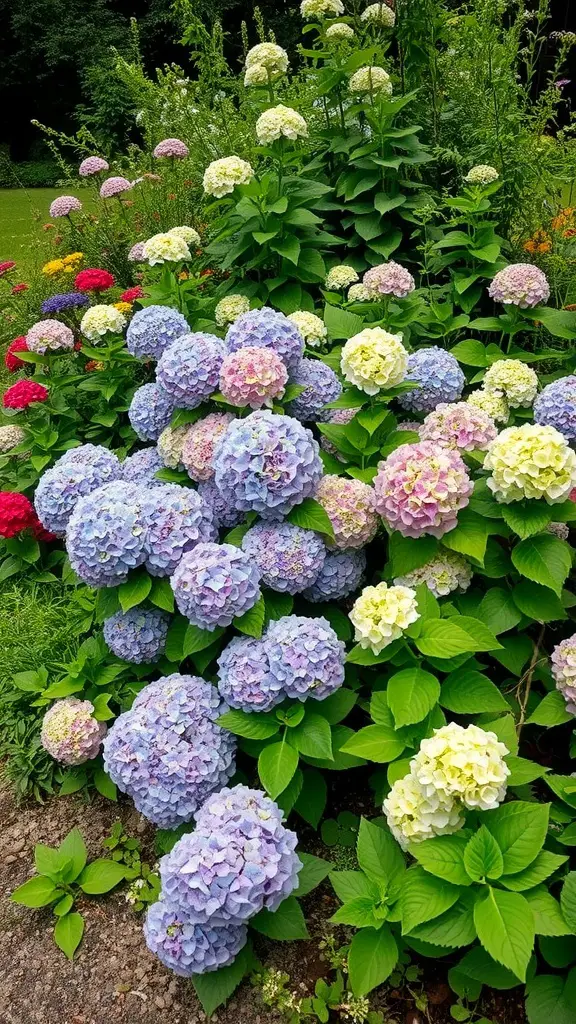
Hydrangeas are stunning flowers that can transform any garden into a colorful paradise. In the image, you can see a beautiful display of hydrangeas in various shades of blue, pink, and white. These blooms create a lovely contrast against the lush green leaves, making them a perfect choice for landscaping.
When planning a hydrangea-themed garden, think about the colors you want to feature. The image showcases a mix of pastel hues, which can add a soft and inviting feel to your outdoor space. You can pair these with other flowers for a vibrant look or let the hydrangeas stand out on their own.
Consider the layout of your garden. Planting hydrangeas in clusters can create a stunning focal point. The image illustrates how these flowers can be arranged alongside other plants, enhancing the overall beauty. Make sure to choose a location that gets enough sunlight and has well-drained soil for the best growth.
Don’t forget about maintenance! Regular watering and occasional pruning will keep your hydrangeas healthy and blooming beautifully. With the right care, your hydrangea garden can be a delightful retreat for you and your guests.
Hydrangeas in Shade vs. Sunlight
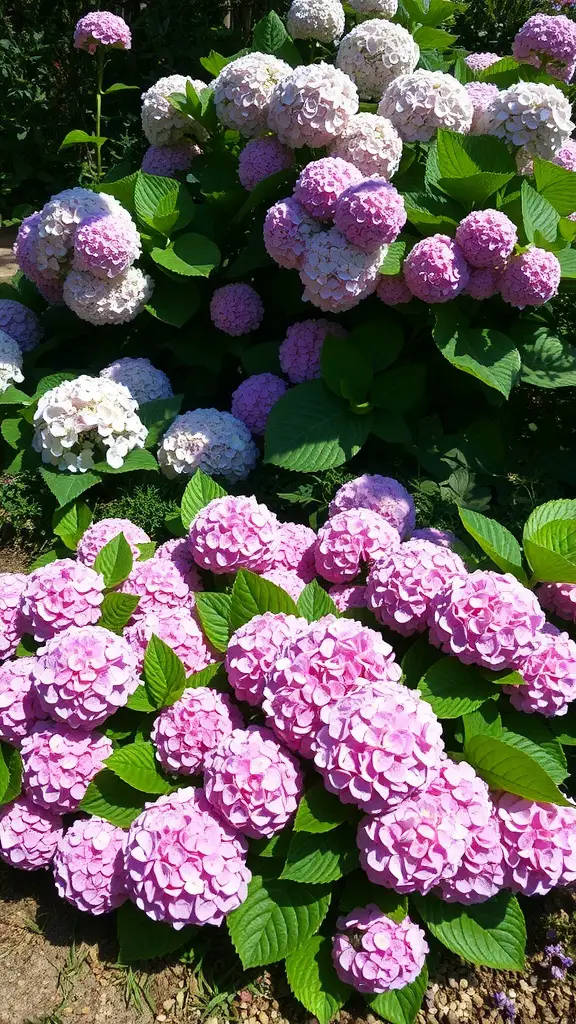
Hydrangeas are stunning flowers that can thrive in various conditions, but their performance can differ based on sunlight exposure. In the image, you can see a beautiful display of hydrangeas, showcasing their vibrant colors and lush foliage.
When planted in sunlight, hydrangeas often produce larger blooms. They love bright light, but too much direct sun can lead to wilting. It’s a balancing act to find the right spot for these beauties.
On the flip side, hydrangeas in shade can still flourish, though their blooms may be smaller. They appreciate the cooler temperatures and can maintain their color longer. If you have a shaded area in your garden, don’t hesitate to plant these lovely flowers there.
Ultimately, whether in shade or sunlight, hydrangeas can bring charm to your landscape. Just remember to keep an eye on their watering needs, as both conditions can affect how much moisture they require.
Understanding Hydrangea Color Changes
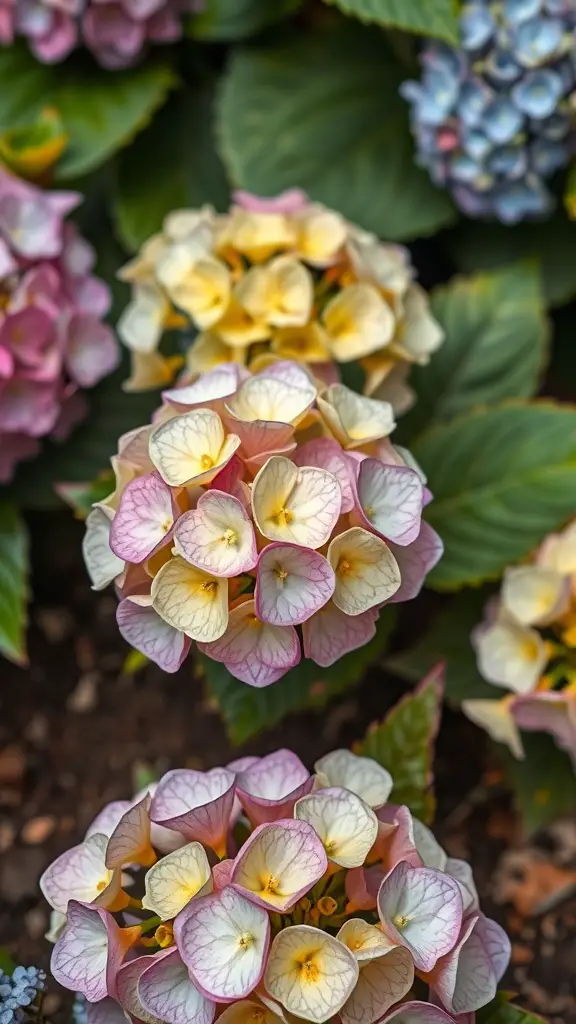
Hydrangeas are fascinating plants, especially when it comes to their color changes. The image shows beautiful blooms in shades of pink, yellow, and blue. These colors can shift based on various factors, making hydrangeas a unique addition to any garden.
The color of hydrangea flowers often depends on the soil’s pH level. Acidic soil tends to produce blue flowers, while alkaline soil results in pink blooms. This means you can actually influence the color of your hydrangeas by adjusting the soil conditions. It’s like having a garden that can change its look with just a little effort!
In the image, you can see a mix of colors, which indicates a healthy plant that may be experiencing different soil conditions or varieties. Keeping an eye on your hydrangeas can lead to delightful surprises as they bloom throughout the season. Whether you prefer the soft pinks or vibrant blues, hydrangeas can bring a splash of color to your landscaping.
Hydrangeas in Cottage Garden Designs
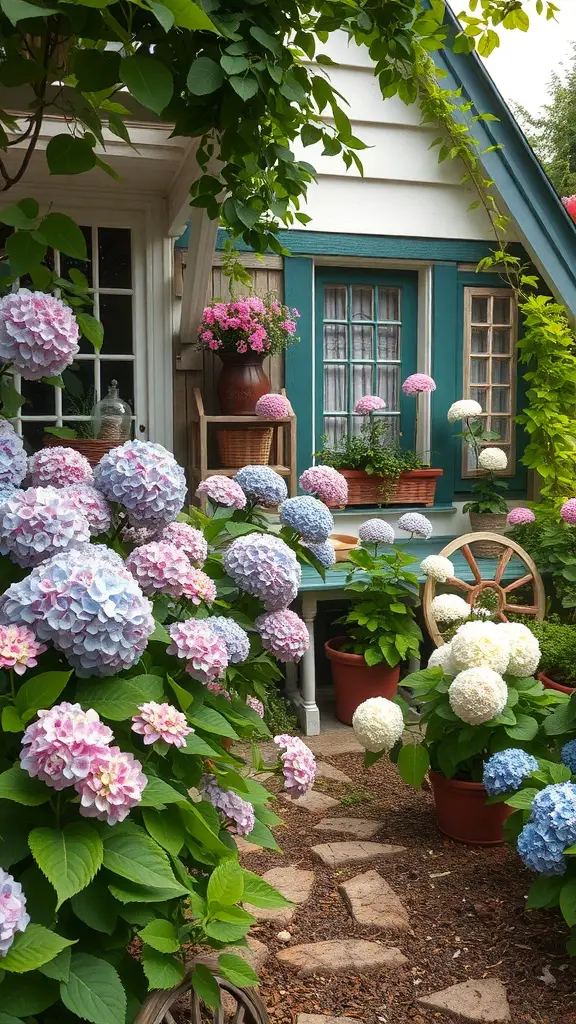
Cottage gardens are known for their charm and cozy feel, and hydrangeas fit perfectly into this style. These beautiful flowers bring a burst of color and texture, making any garden feel inviting.
The image shows a lovely scene filled with hydrangeas in various shades of pink, blue, and white. Their round blooms create a soft, romantic look that complements the quaint cottage in the background. This combination of flowers and architecture is a classic representation of cottage garden design.
Hydrangeas thrive in many conditions, making them a versatile choice for gardeners. They can be planted in clusters or as standalone features, adding depth to the landscape. The way they bloom in summer creates a stunning focal point, drawing the eye and inviting visitors to explore.
Incorporating hydrangeas into your cottage garden can enhance the overall aesthetic. Pair them with other flowering plants and greenery to create a lush environment. The mix of colors and textures will make your garden a peaceful retreat.
Designing Hydrangea Pathways
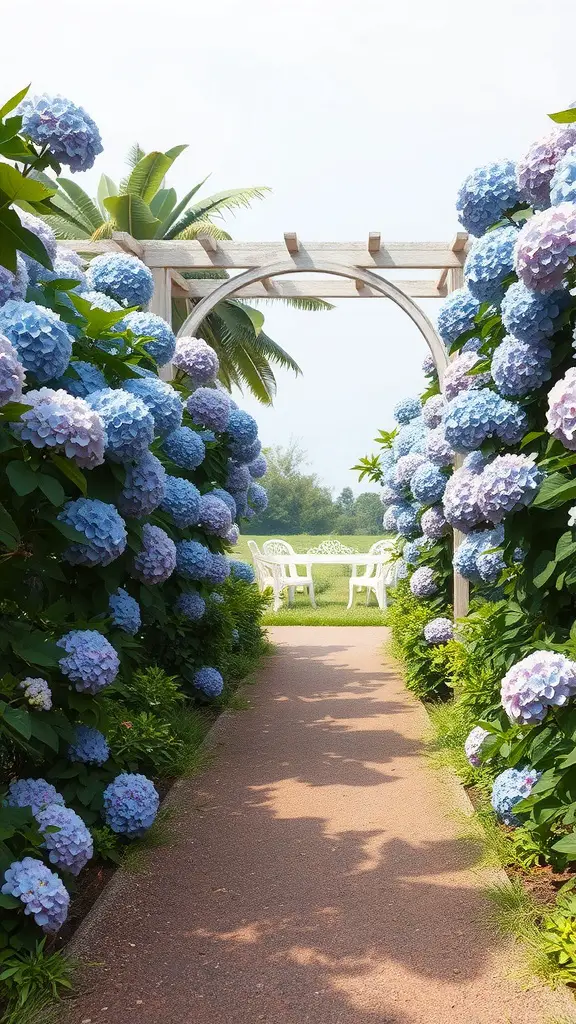
Creating pathways lined with hydrangeas can turn any garden into a stunning retreat. The vibrant colors of these flowers add a cheerful touch to your outdoor space. Imagine walking through a tunnel of blue and purple blooms, with their lush foliage framing your path.
The image shows a beautiful walkway bordered by hydrangeas, leading to a cozy seating area. This setup invites you to take a moment and enjoy the scenery. The archway above adds a charming element, making the pathway feel even more special.
When designing your own hydrangea pathways, consider the variety of hydrangeas you want to use. Some bloom in shades of blue, while others offer pink or white flowers. Mixing these colors can create a dynamic look. Make sure to choose a spot that gets enough sunlight and has good drainage for the best results.
Adding a seating area at the end of the path, like in the image, can provide a perfect spot for relaxation. It’s a great way to enjoy the beauty of your garden while sipping a cup of tea or reading a book. Overall, hydrangea pathways are not just functional; they create a lovely atmosphere that enhances your outdoor experience.


